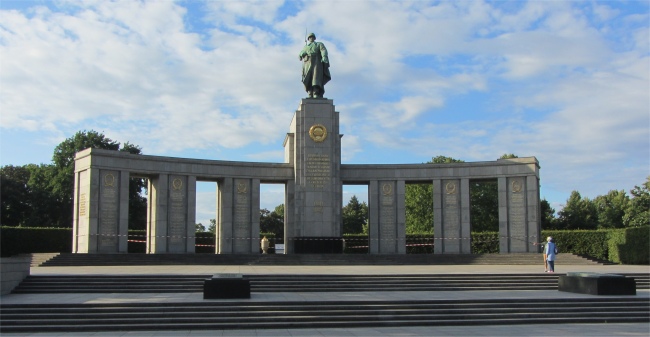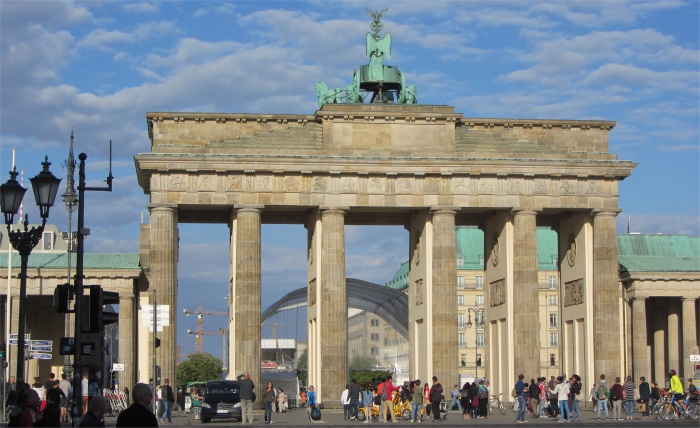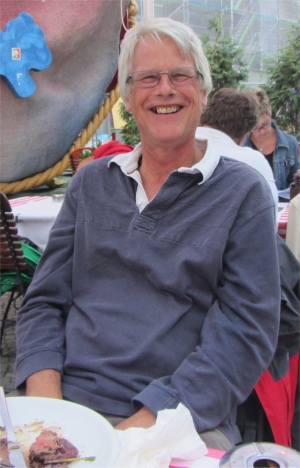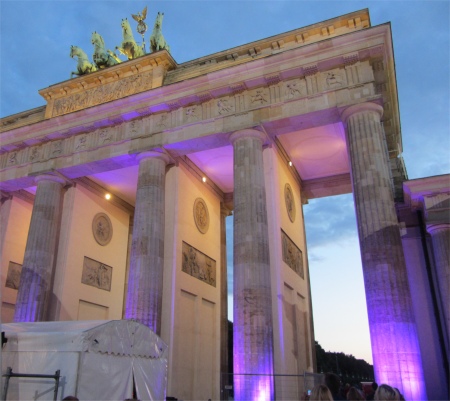Showered, breakfasted, and packed, we were ready to go. Skipper Rex made some last minute notes for Barry and Yvonne, and off we went to get the train to Amsterdam.
At the station we smiled as a dozen little lads, carrying backpacks almost as big as they were, followed their leader in single file across to our platform. No doubt all were off for a camping trip. I was impressed at how well behaved they all were, with no complaints about the loads they were carrying.
Our train took us out of Hoorn, passing acres of allotments on the way, then we were flying silently across fields full of ditches and cattle. Scores of wind turbines waved us on our way. The young lads were scattered across the carriage in isolated seats, all behaving impeccably.
The journey to Amsterdam took just 30 minutes, and it was a simple matter of changing platforms for our train to Berlin. The group of scouts who had travelled down from Hoorn with us were also waiting for the Berlin train, all excitedly chatting away in German. Their leader was a young fellow, probably only in his early twenties, but he seemed to be well in control of his pack.
I feel a sort of romantic excitement being in a station where trains for other countries pass through. Just the thought of uninhibited travel to all those far off lands fills my soul with a mixture of wonder and excitement.
A grey, powerful, slick train glided alongside our platform and almost silently came to a halt. People poured off the train, and had to push their way through the eager throngs trying to get on; organised chaos you could call it. The carriages were of the old-fashioned type I remembered from my childhood: long corridors down the side, lined with doors leading to a series of compartments, each holding six seats. It was a real struggle fighting our way down the corridor against a flow of folk trying to come through it from the opposite direction.
We eventually found our resting place for the next 6.5 hours, and were soon joined by a couple of Italian lads who were probably travelling around Europe on rail cards.
Without much ado, the train effortlessly glided out of the station on time and we were soon hurtling through arable lands, over networks of waterways and road systems, traversing small villages and huge towns. The train occasionally halted at a station, but for durations of no more than two minutes; this train was on a mission. At the German border we stopped for ten minutes for an engine change; apparently some countries prefer to have their own trains pulling carriages or freight. And off we sped again, but now announcements were blurted out in German first rather than Dutch.
The architecture immediately changed, and the lush green Dutch fields gave way to vast fields of cereal crops, some already harvested. At one stage a wondrous sight came into view, mountains, a welcome change to Holland's flat terrain. I was itching to get out for a good hike. Stopping briefly at Wolfsburg, the home of VW, Rex raved enthusiastically about the town's football team, and which Wolfsburg players moved across to play in the English football leagues. It was all lost on me I'm afraid. The 6.5 hour train ride was a challenge, but I ploughed through Martin Johnson's autobiography to pass the time.
Our entry into Berlin was smooth, and we stepped out of our cell into the bright and airy structure of steel and glass that is Berlin Central Station, one of the most spectacular architectural projects of the capital. After undergoing eleven years of construction, the station formerly known as the Lehrter Stadtbahnhof was reopened on 28th May 2006 as the largest and most modern connecting station in Europe.
There are two main levels for train traffic and three connection and business levels. However, it is interesting to note that the concept of a "cathedral of transport" was not quite able to be realised in accordance with the wishes of the architect Meinhard von Gerkan. For example, he had planned on having a vaulted roof but this had to give way to a flat roof. Furthermore, the glass roof above the upper rail system had to be reduced significantly.
Nevertheless, the station is delicate, spacious and full of light. The 321 metre long glass hall for rails running east to west is crossed by the 160 metre long and 40 metre wide concourse where rails are running north to south.
A sophisticated system of large openings in the ceilings at all levels allows for natural light to be let in so that it can even reach the lower tracks. The architecture places an emphasis on the character of the station as a traffic intersection. For the Hamburg-based architects Gerkan, Marg & Partner, the importance of the new Berlin Central Station consists in the fact that it serves as an interface in Europe and this point is the determining factor of their design.
Our hotel was just outside the station, but my entry there was not so graceful. Months earlier Rex had booked two double rooms; one for him and Meryl, the other for me. The same day as he made the booking, I called up the hotel to make sure my room had twin beds, one for me and the other for Dan when he turned up on Saturday. This had all been magically transformed into three rooms, each with twin beds. I was fuming with the guy at the desk, but paid up for the extra room before I really lost my rag.
 Reichstag |
The Reichstag, short for Reichstagsgebäude, was built as a symbol of the newly created German Empire, but the parliament that assembled here had little say in matters; most of the legislative power was in the hands of the chancellor and, until 1918, the emperor. The Reichstag played a significant part in Hitler's ascent to power. In February 1933 a fire broke out in the building, destroying much of the Reichstag. It is to date still unclear who started the fire, but a Dutch ex-communist, Marius van der Lubbe, was charged with the crime and sentenced to death after a show trial. The incident gave a boost to Hitler, at the time chancellor, who blamed the Communists. His party, the NSDAP, gained almost 44% of the votes during the following elections and he was able to pass an amendment that would give him absolute powers. The Reichstag building had now become a mere symbol of a powerless parliament. The Nazis themselves never even used the Reichstag for parliamentary sessions.
The building was not repaired and was damaged even more at the end of the Second World War, when Soviet troops entered Berlin. The picture of a Red Army Soldier raising the Soviet flag on the Reichstag is one of the most famous twentieth-century images and symbolized Germany's defeat. After the Second World War the Reichstag building ended up in West Berlin, right near the border with East Berlin. The iconic dome was demolished in 1954 but the remainder of the building was reconstructed between 1958 and 1972. During Berlin's division the West German parliament assembled here once a year as a way to indicate that Bonn was only a temporary capital. The building stood otherwise mostly empty and plans from the 1970s to use the building as a museum were never realized. In 1991, shortly after reunification, the decision was made to move the Bundestag (Germany's parliament) from Bonn back to Berlin.
 Russian Memorial |
We took a stroll down through the expanse of parkland known as the Tiergarten (zoo) to the Strasse des 17. Juni, where we turned down towards the Reichstag Building, passing the Sowjetisches Ehrenmal (Soviet Memorial) to our left. Here, right in the centre of the capital, two "T 34" tanks flank the bronze statue of a red army soldier who is carrying his rifle over his shoulder. The columns behind him bear texts with the names of fallen Soviet soldiers, while the graves of about 2,500 soldiers are in the rear of the memorial. This memorial was erected in 1945 on the north side of today's Straße des 17. Juni near the Reichstag to honour the fallen soldiers of the red army.
 Brandenburg Gate |
The monumental gate was commissioned by Emperor William II as the replacement of an older gate. Architect Carl Gotthard Langhans based his design of the new gate, which measures 65.5m wide and 28m tall, on the Propylaea, the gateway to the Acropolis in Athens. The gate was named Friedenstor (Peace Gate) since it was meant to symbolize a period of peace after years of war during the reign of Frederick the Great. Construction of the Brandenburg Gate started in 1778 and it officially opened in 1791. The decorations, including bas-relief scenes depicting Greek mythology took another four years to complete. The gate has five passages. The central and widest one was reserved for the royals; the adjacent passages were for use of the aristocracy while ordinary citizens were only allowed to use the outer two.
The bronze quadriga of victory crowning the gate was created in 1793 by Johann Gottfried Schadow. The four-horse chariot is driven by the winged goddess of peace. In 1806, when Berlin was occupied by French troops, Napoleon ordered the quadriga to be taken to Paris. After Napoleon's defeat at the Battle of Waterloo, the quadriga was triumphantly taken back to Berlin, and was turned into a symbol of victory: an iron cross and eagle were added to the laurel wreath. At the same time the square near the gate was renamed Pariser Platz and the statue on the quadriga was now called Victoria, after the Roman goddess of victory.
The Brandenburg Gate, which had become a symbol of Prussian militarism, was badly damaged during World War II. After the division of Berlin between the allied powers it ended up in the Russian sector, right near the border with the British sector. The gate was repaired in 1956-1958 by East Berlin and West Berlin funded the reconstruction of the destroyed quadriga, which was created from the original mould. The iron cross and eagle, symbols of Prussia, were removed by the Communist regime but they were added again after reunification.
On August 14, 1961, one day after the construction of the Berlin Wall, the Brandenburg Gate closed. Pariser Platz was now a desolate wasteland and the gate became to symbolize the division of Berlin and Germany. When the Wall finally fell in November 1989, people flocked to the Brandenburg Gate to celebrate. The gate, which reopened in December that year, was thoroughly renovated in 2000-2002 and now stands as a symbol of a reunited Germany. Meanwhile Pariser Platz directly behind the Gate has completely been redeveloped and regained much of its nineteenth-century grandeur.



